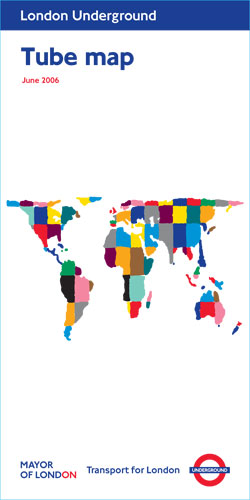The London Underground and Mapping.
I decided to look at the London Underground after today's lecture, we picked up on it in the lecture and I found it really interesting the way that the tube map is so iconic and is instantly recognisable. After looking at Harry Beck, the man who designed the tube map and how it has developed over the years, I decided to see how a map has been an inspiration for art work and also has been incorporates and used in other maps and underground networks all over the world, for example the Paris Metro uses a similar mapping system and so does the New York Subway, I will show these images below. The tube map was a map that was very easy to understand, this was because of the bold range of colours that were used to stand for each train line, your eyes are instantly drawn to which colour you needed when travelling to certain places, for example, the yellow line is Circle, blue is Victoria and red is Central, these are just a few of the lines.
The London underground map was named one of the most iconic British design in a recent poll. The London Underground map, the Spitfire and Concorde have been voted Britain's three favourite designs of the last century. Design Museum visitors and viewers of BBC Two's The Culture Show were asked to choose from 25 design icons. Among them were the Routemaster bus, the Mini, red phone boxes and more recent inventions such as the world wide web and video game Tomb Raider. A public vote will decide which of the three is Britain's most iconic design. The London Underground map was designed by Harry Beck in 1931 when the Tube grew so large it became impossible to map the lines and stations geographically. [1]
The next thing I looked at was the front covers of the tube maps. In the last few years they have used artwork which is linked to the London Underground to illustrate the front covers of the map. All the art works are different and have different meanings.
One of the artworks was by Michael Landy was a drawing of the palm of a hand with different colour lines symbolising the different tube lines, I went onto the Transport for London's website and found this information about it, the work is a tracing of the artist’s own hand in pencil; the creases and lines of the hand are represented by lines drawn in the various colours of the Tube map. In this way, Landy makes a direct relationship between ‘the artist’s hand’ and the Pocket Tube Map. We can read his palm and see how his personal journeys have left their mark there. Reproduced as a pocket artwork for millions of Tube travellers to hold in the palm of their own hands, the work has a humorous yet uncanny quality. Head of Art on the Underground, Tamsin Dillon, said: “I like the way that Landy brings us back to the physical workings of the Tube Map. His reference to the way that people write on their hands as an aid memoire is very much in contrast to current handheld technology – like GPS and Google Maps. The Pocket Tube Map is a traditional, ‘hands-on’ guide, which is still a great way to get around the London Underground system.” [2]
Another one which I looked at in more detail was one by Jeremy Deller, He did a detailed drawing using colours which signify the London Underground train lines, the colours are subtle but still are recognisable to the tube. I looked on the Transport for London website again and found this, Deller has been commissioned by Art on the Underground (the London Underground art programme) to create the next cover artwork for the London Underground Pocket Tube Map and has chosen to produce a delicate, line-drawn portrait of John Hough with artist Paul Ryan. As more and more elements of the Transport for London system are becoming digitised, the work reminds us of the thousands of people behind the scenes working on the ground to bring it to life. Portrait of John Hough is the latest in a line of commissions by Art on the Underground for the Pocket Tube Map cover. These have included works by some of Britain’s most exciting artists, including Yinka Shonibare, David Shrigley, Liam Gillick, Gary Hume and Emma Kay. Each artist is asked to respond to the challenge by following an informal set of rules, such as referring to the location of the work or incorporating the familiar colours and lines of the iconic London Underground map. [3]
[1]BBC. (2006). Top three 'iconic' designs named. Available: http://news.bbc.co.uk/1/hi/england/london/4769060.stm. Last accessed March 2013.
[2]Michael Landy. (2011). All my lines in the palm of your hand. Available: http://art.tfl.gov.uk/projects/detail/3581/. Last accessed 15th April 2013.
[3]Jeremy Deller. (2007). Portrait of John Hough. Available: http://art.tfl.gov.uk/projects/detail/1119/. Last accessed 15th April 2013.
Where I got my images,
http://www.aparisguide.com/maps/metro.gif
http://images.nycsubway.org/maps/calcagno-2010-06-28c.gif
http://now-here-this.timeout.com/wp-content/uploads/2012/06/Artwork-A-Z-Tube-map-poster-by-Tim-Fishlock-2010.jpg
http://art.tfl.gov.uk/file-uploads/large/pocket-tube-map-feb-06.jpg
http://art.tfl.gov.uk/file-uploads/large/barbara-kruger-tube-map-cover-.jpg
http://image.guardian.co.uk/sys-images/Arts/Arts_/Pictures/2008/01/09/corneliatube460jpg.jpg
http://art.tfl.gov.uk/file-uploads/large/jpeg--final.jpg
https://blogger.googleusercontent.com/img/b/R29vZ2xl/AVvXsEhC24c-D3ovvGKjfVSuMNAZIGxcosK9HQxldRDqpz4qWx4bN7vJRWlgd6pkZ-CEwfXm1yy6nfoUdtmhT4Xx4Zu4-B0tyIQ52I7ONXlyNOjYVB8zNypzLdZ6EYXmpd2qwuAEu__f9JiTyvUK/s1600/2006+2Tube-map-art-Yinka-Shonib-008.jpg
http://www.designweek.co.uk/Pictures/web/y/k/s/Tupe-Ma_468.jpg
http://art.tfl.gov.uk/file-uploads/large/pocket-map-cover.jpg
























